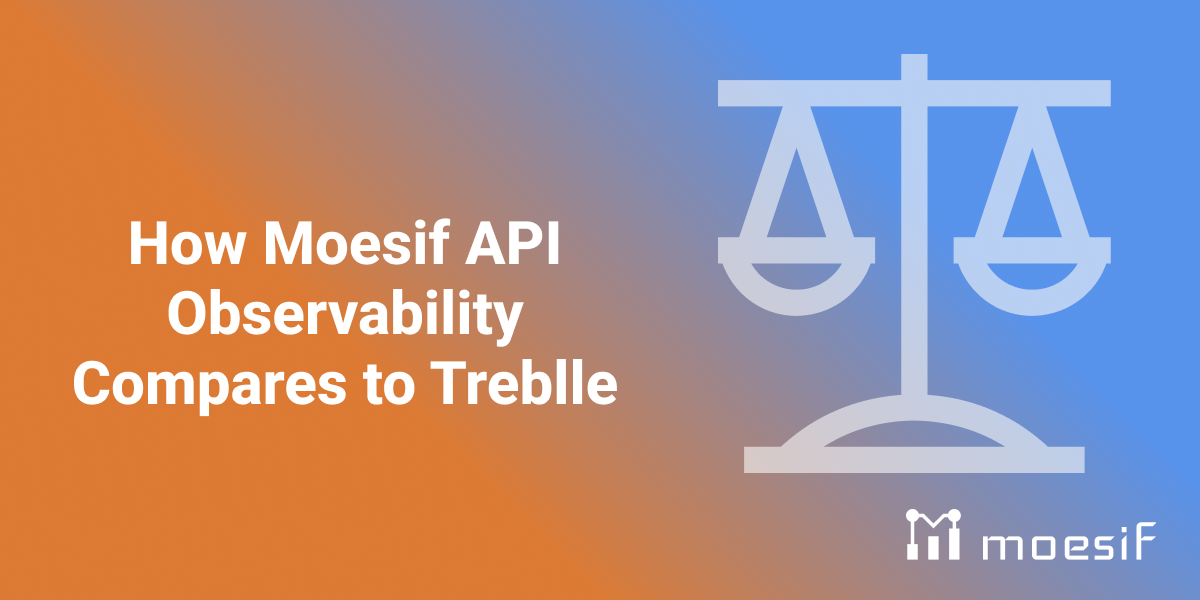How Moesif API Observability Compares to Treblle

API observability plays a crucial role in making sure that your API delivers its fullest potential and consistency. Therefore, it’s important to choose the right tool for your observability requirements.
In this article, we take a look at two API observability tools—Moesif and Treblle. We briefly discuss the key components of API observability. Then we dive into how Moesif and Treblle compare with each other. By the end of this article, you can make an informed decision about which tool to pick for your use case.

About Moesif
Moesif is a comprehensive API platform with powerful tools for user-centric API observability, providing in-depth insights into API usage and customer interactions. Some highlights of Moesif include the following:
- Advanced user behavior analytics.
- High-cardinality data analysis.
- Real-time event monitoring and alert systems.
- API monetization with quotas and governance enforcements.
About Treblle
Treblle provides an end-to-end APIOps platform for REST APIs supporting API observability with real-time analytics and metrics data. Other features include API governance and automated API documentation. Some highlights of Treblle’s features include the following:
- Analyzing over 40 API-specific data points.
- Error tracking and alert notifications.
- User agent and location based usage and consumer analysis.
What is API observability
API observability provides deep and valuable insights into APIs. In complex and distributed systems, observability helps you understand APIs as they interact with different services. Observability empowers teams with the ability to proactively maintain and optimize their products based on real-time data.
An API observability platform provides a centralized hub for analytics and visualization around the four key components of API observability:
- Metrics
- Events
- Logs
- Traces
Metrics
An API metric provides quantitative data in specific time intervals in a period of time. For example, response times and errors and request counts. Metrics help you assess the health and performance of your API, leading to optimizations and performance gains. For example, analyzing throughput and latency can measure your API’s efficiency in processing requests.
Events
In the context of APIs, an event represents a meaningful business decision taken by part of the system to provide value. More often than not, it also accompanies a state change in the system. For example, API calls, users signing up, or subscribing, and so on. An API observability tool tracks these events in real time.
Logs
Logs keep thorough records of events within an API. For example, timestamps, durations, user agent data. Most API frameworks and observability tools support keeping API logs.
Logs help debug and understand more about the data flow within an API. Logs also provide context around requests, responses, and errors, helping developers troubleshoot issues such as latency or error spikes.
Traces
Traces give detailed visibility into a request’s entire journey through the API and the services the API connects to. When debugging, developers can correlate traces with events and logs. Thus in a distributed system, traces help pinpoint the exact underlying component or stage causing issues.
API Observability with Moesif and Treblle
Now that we have discussed the basic concepts in question, let’s start comparing Moesif and Treblle in terms of their offerings for API observability:
API Metrics and Analytics
Moesif
Moesif’s API analytics suite allows you to grow your business through a deep understanding of product usage and customer behavior in real time. Moesif’s multifaceted analysis types can serve different business requirements and scenarios:
- Real-time event tracking.
- Time-series and heatmap analysis.
- Segmentation and aggregation by criteria such as demographics and HTTP data.
- Funnel analysis like Time to First Hello World (TTFHW).
- Lookups, retention, and customer composition analysis for users and companies.
Treblle
Treblle prioritizes pre-defined analysis widgets that you can compose your dashboard with. These widgets contain a variety of metrics like the following:
- Monthly and weekly breakdowns of your APIs usage.
- Top geographic locations of your users.
- User device statistics.
- Daily request frequency and request maps.
API Logs and Monitoring
Moesif
Moesif boasts a robust set of monitoring features that monitor your API’s journey and the user experiences end-to-end. Moesif can automatically send important alerts, such as API performance issues, security threats, and more. You have complete control over notifications, including what to get notifications for and how.
Some of these API monitoring features include the following:
- Creating real-time alert rules on any analytics chart.
- Setting up notifications through PagerDuty, Slack, email, or custom webhooks.
- Multi-dimensional alerts for customer-based metric tracking, quiet periods, and more.
- Advanced anomaly detection.
Moesif collects logs for both API calls and custom actions. Custom actions represent custom events like users signing up or payment processing. You can leverage event streaming services like AWS Firehose to track and log custom actions.
Moesif’s Live Event Log captures API request and response details including timestamps, IP addresses, user agent data, and so on. In Moesif, you can search and inspect full event logs from last year, not only previews of new events
Treblle
Treblle measures and collects data about your API’s health, performance, and security in the dashboard, but doesn’t support real-time notifications and alerts out-of-the-box. But you can use separate Treblle applications to get real-time alerts about your API.
Treblle also doesn’t support making custom alert rules that you want to get notified about.
Custom Dashboards and Embedded Metrics
Moesif
Moesif offers customizable and self-serving metric reports that you can organize into workspaces. You can also share metric reports and charts in a variety of ways with different audiences. Moesif also allows you to securely embed metrics into user-facing applications and internal workflows. These features let you collaborate across every layer of your business to make important decisions that directly bring value.
Treblle
Treblle offers pre-defined analysis widgets that you can customize your dashboard with. Custom widgets or metric reports aren’t supported.
It supports custom integrations by creating your own SDK, but you can’t embed the charts Treblle generates into external mediums like apps and web pages.
Treblle also allows you to share individual requests or a set of requests publicly. Sharing metrics and charts aren’t supported.
API Protocol Support
Moesif
Moesif supports the following API protocols:
Treblle
Treblle only supports REST APIs.
Compliance and Security
Moesif
Moesif maintains SOC 2 Type 2 compliance and possesses certification with EU-US Data Privacy Framework. For more information, see Security Program at Moesif.
Treblle
Treblle is SOC 2 Type 1 and ISO 27001 certified. For more information, see Security at Treblle.
Conclusion
Choosing the right API observability tool marks a critical decision for any organization that relies on APIs for its success. Both Moesif and Treblle offer valuable features, but Moesif’s comprehensive approach to API analytics, monitoring, and security gives it a distinct edge.
With Moesif, you gain a deeper understanding of your API performance, user behavior, and potential bottlenecks. Its advanced features, such as high-cardinality analysis, real-time alerts, and robust security compliance, allow you to proactively address issues, optimize your APIs, and drive business growth.
If you’re looking for a powerful, user-centric API observability platform that provides unparalleled insights and control, Moesif comes out as the clear winner.
If you’re ready to experience the difference, sign up today for a free trial, no credit cards required, and discover how Moesif can revolutionize your API strategy.
Next Steps







